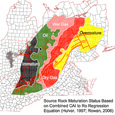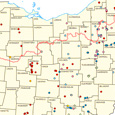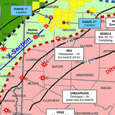Considerations prior to signing pipeline easements
Thursday, March 29, 2012
With the drilling of gas wells comes the need to establish pipelines to move the gas from the point of drilling to the end users. Because of this, you may be contacted to sign an easement agreement with a company granting the right to have a pipeline constructed on part of your land.
It is important to develop an agreement prior to construction that clearly communicates to everyone involved what is expected.
Explanation
What is a pipeline right-of-way? A pipeline right-of-way is a piece of land, granted to a pipeline company, on top of and on either side of a natural gas pipeline. This right-of-way is also referred to as an easement which provides certain interests and restrictions to the land that allows the pipeline company to install and maintain the pipeline.
Who approves pipelines?
The Federal Energy Regulatory Commission approves the location, construction and operation of pipelines, facilities and storage areas involved in moving gas across state lines.
The Public Utilities Commission of Ohio has regulatory authority over pipelines within Ohio and the Ohio Power Siting Board has authorization to issue certificates for the construction, operation and maintenance of utility facilities.
Standards and specifications
The Ohio Department of Natural Resources Division of Soil and Water Conservation has developed a model Pipeline Standard and Construction Specification document to provide guidelines for controlling and minimizing any adverse impacts of pipeline construction on Ohio’s soil and water resources.
These standards were developed by the ODNR-DSWC when a 42-inch natural gas pipeline, known as the Rex Express Pipeline-East Project, was constructed in Ohio.
Following is a review of items included in the agreement and provides landowners who may be considering the placement of a pipeline across their land with important considerations prior to, during, and following construction.
Because of space limitations, not all of the specifics of this agreement can be described here. However, a detailed copy of this document is available from your local Soil and Water Conservation District office or online at www.dnr.state.oh.us/tabloid/22295/Default.aspx.
If you are contacted to sign an easement for pipeline construction on your property, consult with an attorney and consider the following recommendations.
Planning phase
Construction plans and maps — General construction plan maps should include information about pasture, fencelines, cropland, unique agricultural lands and land enrolled in any Farm Service Agency or Natural Resources Conservation Service programs.
Landowners should also require that the company, on the construction maps and plans, note the following information:
A. Subsurface drainage areas that can be identified, open ditches, diversions, terraces, buried utility lines, water sources, and unnamed water flows.
B. Depth of cover if it differs from the construction specifications.
C. Any off right-of-way roads, work, or storage areas.
D. Planned location of any compressor or valve stations, metering or regulating stations, and any other proposed facilities.
E. General location of trench breaks.
F. Locations for subsurface drains.
Sensitive agricultural soils — These are lands defined as cropland, hayland or pasture that are more prone to disturbance during construction than other soils. Information on these soils can be found by consulting your county Soil Survey available through your local Soil and Water Conservation District.
Point of contact during construction — Your agreement should provide you with contact information for the representative assigned to your project.
Construction specifications
In the agreement you develop with the pipeline company the following areas need to be addressed:
A. Ingress and egress routes — It is important to have a mutually agreed upon plan for where the company can and can’t access the land prior to, during, and following construction.
B. Temporary roads — whenever possible, existing roads should be used. If temporary roads are established provisions should be in place for what will happen to these roads following installation.
C. Cleaning of brush and trees on the right-of-way — consideration should be given as to how these will be cleared and disposed.
D. Topsoil removal and protection — all topsoil should be removed, stockpiled, and returned to restore the original soil profile.
E. Depth of Cover — pipelines should be buried as deep as possible, with the minimum being 36 inches.
F. Rock removal — backfill materials should not include rocks greater in size than those originally removed.
G. Repair of damaged and adversely affected tile lines — it is suggested that all repairs and/or replacement of tile lines be completed prior to the replacement of topsoil.
H. Control of trench washouts, water piping, and blowouts — trench breakers should be installed to minimize these problems.
I. Pumping of water from open ditches — no backfilling should occur in open ditches and provisions should be in place for water removal.
J. Subsoil decompaction, soil shattering, and stone removal — the cost of applying fertilizer or other necessary soil amendments should be included in the damages paid. Landowners may want to consider providing a stated time in which subsoil decompaction and soil replacement may not occur.
K. Backfill profile and trench crowning — on lands where materials excavated during trenching are insufficient in quantity to meet backfill requirements, it is suggested that the soil of adjacent agricultural land not be used as backfill or cover material.
Remediation and monitoring. The Pipeline Standard and Construction Specifications document also provides for a minimum two year period of general and specific monitoring and remediation and a point of contact for questions related to remediation and monitoring.
These areas should also be addressed if you are considering entering into an easement agreement.
Summary. If you are in a position to negotiate an easement for the construction of a pipeline on your property it is important to understand the implications of an easement and to make certain an agreement is written that meets your goals and protects soil and water resources.
Ohio State University Extension has a number of Extension educators and specialists with expertise in a variety of topics related to shale gas development. Contact your local Extension office to receive non-biased answers to your questions about this topic.
This article is not intended to provide any legal advice. All landowners are strongly encouraged to consult an attorney before entering into any easement agreement.




